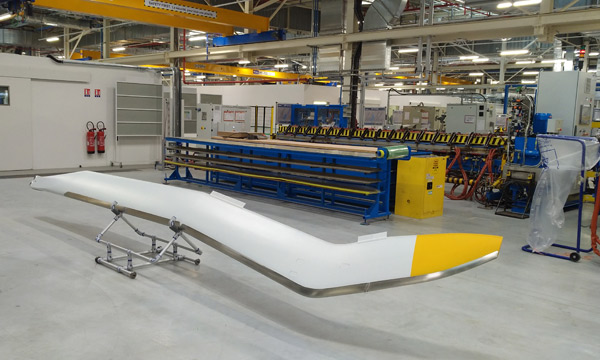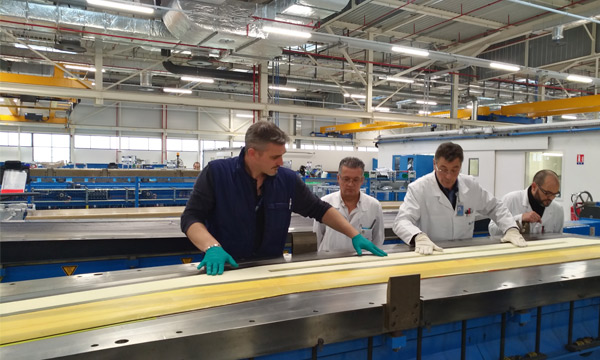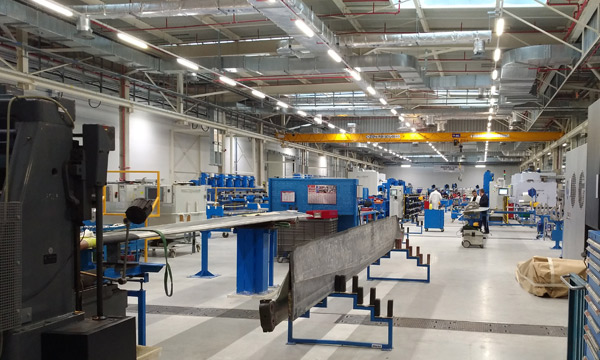Airbus Helicopters inaugurates its new rotor blade factory at Paris-Le Bourget |
| Léo Barnier |
|
|
14 DEC 2017 | 887 words
|
 |
All pictures © LB - Le Journal de l'Aviation - all rights reserved |
|
|
|
The cream of the French aviation industry came together at Dugny (Seine-Saint-Denis) on Friday 1st December to attend the inauguration of its new rotor blade factory. The event, which was presented by Guillaume Faury, CEO of Airbus Helicopters, took place under the patronage of the French Transport Minister Elisabeth Borne and Fabrice Brégier, the Airbus group's No. 2. Located on the edge of Paris-Le Bourget airport, in time this factory will become the centre of excellence for blades for the helicopter manufacturer's entire range.
Anyone who is used to attending the Le Bourget show or visiting the Air and Space Museum won't necessarily find their way around easily. The Airbus Helicopters factory is actually positioned on the other side of the airport runway, at the old air force base. It occupies a 178 000 m² plot of land, with 60 000 m² of built-up surface area. The factory has around twelve buildings - management, surface treatment, testing, logistics (with Daher), reception and so on - based around a 40 000 m² central hall. This is where the core of its activities are based, with production lines and blade repair workshops.
 The plant adopts in-line manufacturing processes. © Copyright Léo Barnier/Le Journal de l'Aviation
The plant adopts in-line manufacturing processes. © Copyright Léo Barnier/Le Journal de l'Aviation
A move towards new industrial standards
This huge building is broken down into several separate areas for each activity, but which are open to each other. The lack of any physical separation adds to the impression of space. The production workstations meet industrial standards with an in-line organisation, intended to reduce manufacturing time and improve quality. Only the section dedicated to the H160 is still "rough", as the programme is still in the development phase.
In comparison with La Courneuve, Paris-Le Bourget also integrates new production resources. "We are looking at the factory of the future, with digitisation, automation and cobotisation", explains Guillaume Faury. "We have introduced new, more industrial resources, with traceability, a digital activity management system and so on. We now have a common set of data between our different connected factories via a single platform for the whole group." Cobotisation is mainly used to help technicians with drilling and painting tasks, but it should gradually be extended to the manufacturing processes.
One part of the building is dedicated to repair workshops. The blades - which today are made exclusively from composites - may be fully repaired and reconditioned. Depending on the operating conditions, they have a potential lifetime of 25 000 hours in rotation. This time may be significantly reduced for offshore operations or operations in sandy environments.
A test building is located just off this main hall. Airbus Helicopters has electric, sound (tap test) or radiographic inspection resources to check production conformity. There is also a fatigue bench for development activities and structure repair process qualification. The site is home to the design and definition and calculation offices and customer support services.
 Production of the blades of the H160 is set up. © Copyright Léo Barnier/Le Journal de l'Aviation
Production of the blades of the H160 is set up. © Copyright Léo Barnier/Le Journal de l'Aviation
Specialisation strategy
For now, Paris-Le Bourget is responsible for producing all the blades intended for the Airbus Helicopters "French range". Only the rotor blades for the H135 and H145 are still manufactured in Germany. The objective is to concentrate all production at this single site. This will be done gradually, as the Airbus Helicopters range develops, as Guillaume Faury explains: "It would cost a fortune and would create shock waves in human terms if we were to transfer activities for the current programmes. "
This desire to group everything together is part of the helicopter manufacturer's site specialisation strategy. Guillaume Faury quotes the example of Albacete, in Spain, which will bring together production for all rear sub-assemblies (equipped tail beams), while Donauwörth, in Germany, will be responsible for central fuselage sections.
Launched in 2011, the project required 130 MEUR investment from Airbus Helicopters. It also required organisation of the major transfer of the activities which until now have been based at La Courneuve. It took no less than six months to transfer several hundred machines weighing 1 to 45 tonnes between the two sites and set up the 640 employees.
 The repair shop for large blades. © Copyright Léo Barnier/Le Journal de l'Aviation
The repair shop for large blades. © Copyright Léo Barnier/Le Journal de l'Aviation
Employee developments
The number of jobs may change over the next few years, subject to different factors. Around thirty jobs are still included in the voluntary departure plan (out of a total of 582 jobs in France). Jobs may still be created for increases in activity. Above all, the digital transformation will require Airbus Helicopters to recruit people with different backgrounds, as Guillaume Faury explains: "Jobs are changing with an increase in technological level. We have technicians with new, more multi-purpose tasks. Certain jobs are disappearing and others are emerging, in particular in IT, cyber-security and so on".
The CEO continued, explaining that it is difficult at the moment to find people with these skills and took the opportunity to ask training organisations to work more quickly to integrate new technologies into their programmes. |
|
 |
Léo Barnier
Specialized journalist
Industry & Technology, Equipments, MRO
|
|
| |
They made this section possible |
|
|
|
|
|
|
|
|
|
|
|
|
|
|
|
|
Top stories |
|
|
|
|
|
Top stories
|